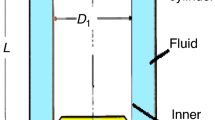Abstract
A dynamic rheological technique is presented that can be used for the prediction of physical stability of concentrated dispersions containing particulates, as well as product development and quality control. Typical physical evaluation frequently requires weeks or months before an assessment can be made. By using dynamic rheology, the prediction of physical stability can often be accomplished in less than three (3) hours. The dynamic or oscillatory rheology technique is performed in two parts. First, a strain sweep test (frequency constant, strain variable) defines the linear viscoelastic range (LVR). Second, frequency scans (from 0.01 to 5.0 Hz) are performed at various temperatures, from 5 to 49°C (40–120°F). It is critical that the frequency scans are performed in the LVR. Dynamic rheology measurements yield data on the elastic (G′) and viscous (G″) moduli. Plotting the elastic to viscous moduli ratio as a function of frequency and temperature generates a 3-D surface which is a “fingerprint” of the dispersion’s colloidal stability. The G′/G″ ratios correlate well with observed physical stability properties. A volume index or a simple mean/variance calculation can be used to assign a value to the graphical 3-D representations.
Similar content being viewed by others
References
de Nemours, E.I. Dupont,Strategy of Formulations Development, E.I. du Pont de Nemours and Company, Wilmington, DE, 1982.
Green, H., and R.N. Weltmann,Ind. Eng. Chem. Anal. Ed. 18:167 (1946).
Goodwin, J.W.,Colloidal Dispersions, Henry Ling Ltd., Dorset, England, 1982, pp. 165–196.
Schramm, G.,Introduction to Practical Viscometry, Gebröder HAAKE Gmbh, W. Germany, 1981.
Tadros, Th.F., editor,Solid/Liquid Dispersions, Academic Press, New York, NY, 1987, pp. 183–273.
Mewis, J., and A.J.B. Spaull,Adv. Colloid Interface Sci. 6:173 (1976).
Ferry, J.D.,Viscoelastic Properties of Polymers, Wiley and Sons, New York, NY, 1980, p. 11.
Mewis, J., and R. de Bleyser,J. Coll. Int. Sci. 40:360 (1972).
Frith, W.J., T.A. Strivens, and J. Mewis, Ibid.:55 (1990).
Tadros, Th.F., and I.M. Krieger,Applied Industrial Rheology, Center for Professional Advancement, East Brunswick, NJ, 1987, H1–15.
Cox, W.P., and E.H. Merz,J. Polym Sci. 28:619 (1958).
Tschoegl, N.T.,The Phenomenological Theory of Linear Viscoelastic Behavior, Springer-Verlag, New York, NY, 1989, p. 84.
Ferry, J.D.,Viscoelastic Properties of Polymers, Wiley and Sons, New York, NY, 1980, p. 46.
Tobolski, A.V.,J. Appl. Phys. 27:673 (1956).
Ferry, J.D.,Viscoelastic Properties of Polymers, Wiley and Sons, New York, NY, 1980, p. 271.
Colby, R.H.,Polymer Preprints 30:52 (1989).
Knudson, M.I., and R. Menking,HAPPI 22(11):80 (1985).
Author information
Authors and Affiliations
About this article
Cite this article
Reboa, P.F., Fryan, M.C. Rheological prediction of the physical stability of concentrated dispersions containing particulates. J Am Oil Chem Soc 69, 71–79 (1992). https://doi.org/10.1007/BF02635880
Received:
Accepted:
Issue Date:
DOI: https://doi.org/10.1007/BF02635880




